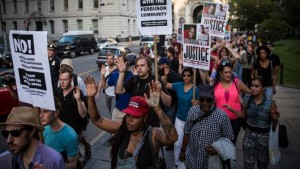
The tragic events unfolding in Ferguson, Mo., following the police shooting death of a young African-American man have ignited a national conversation around deeply rooted racial tensions in America. On Monday at Michael Brown’s funeral, where thousands of family, friends, civil rights leaders and residents gathered, came calls for justice and dignity for all families. But while Brown’s death is an anguishing reminder of racial profiling and police distrust—particularly among men of color—it is just the tip of the proverbial iceberg demonstrating how many factors shape institutional racism and structural discrimination against communities of color.
Missouri’s legacy of institutional racism extends far beyond law enforcement: Housing discrimination, economic disparities and reproductive oppression have long suppressed communities of color. Put together, these factors undermine reproductive autonomy for women of color, particularly the right to have children and to parent those children with the proper supports.
Prior to the 2014 legislative session, Missouri had a failing grade from a national reproductive-health organization (pdf) because of its 24-hour waiting period, parental-consent laws and limited access to abortion services (pdf), which place unnecessary burdens on women in the state. Missouri prohibits the use of telemedicine for medical abortions, despite the fact that 73 percent of women in the state live in a county without abortion services. And HIV education is mandated, but education on basic condom usage is not. To add insult to injury, Missouri has decided not to expand Medicaid under the Affordable Care Act.
Then there is the economic reality. With a population that is 67 percent black and 29 percent white, Ferguson has an unemployment rate that is currently 13 percent, which is more than double the rate in 2000. In the same amount of time, the wages of those employed fell by one-third and the number of those living in poverty doubled. In Ferguson, 20 percent of residents live below the poverty level, with the poorest residents being females of reproductive age and single heads of households. The rate of children living below the poverty level in Ferguson is 25 percent, which is higher than the national average of 22 percent and the Missouri state average of 20.3 percent. Nearly half of all homes in Ferguson are struggling, and communities of color have been foreclosed on at twice the rate of white homeowners in the area.
A city with a two-thirds African-American population has a police force with only three African-American officers and only one African-American City Council member, and crime statistics in Ferguson are as troubling as reproductive-health outcomes for the state. This year alone, African Americans were arrested eight times more than whites in Ferguson, making its arrest ratio higher than that of St. Louis County, which has an arrest ratio of 5-to-1, compared with the national average of 3-to-1.


